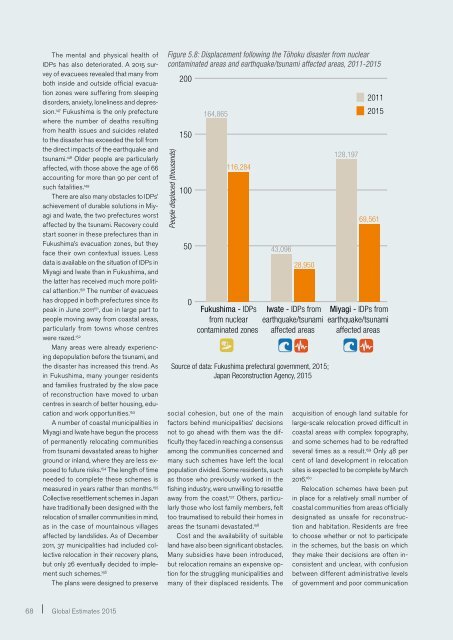Estimates
bzTPL9
bzTPL9
- No tags were found...
Create successful ePaper yourself
Turn your PDF publications into a flip-book with our unique Google optimized e-Paper software.
The mental and physical health ofIDPs has also deteriorated. A 2015 surveyof evacuees revealed that many fromboth inside and outside official evacuationzones were suffering from sleepingdisorders, anxiety, loneliness and depression.147 Fukushima is the only prefecturewhere the number of deaths resultingfrom health issues and suicides relatedto the disaster has exceeded the toll fromthe direct impacts of the earthquake andtsunami. 148 Older people are particularlyaffected, with those above the age of 66accounting for more than 90 per cent ofsuch fatalities. 149There are also many obstacles to IDPs’achievement of durable solutions in Miyagiand Iwate, the two prefectures worstaffected by the tsunami. Recovery couldstart sooner in these prefectures than inFukushima’s evacuation zones, but theyface their own contextual issues. Lessdata is available on the situation of IDPs inMiyagi and Iwate than in Fukushima, andthe latter has received much more politicalattention. 150 The number of evacueeshas dropped in both prefectures since itspeak in June 2011 151 , due in large part topeople moving away from coastal areas,particularly from towns whose centreswere razed. 152Many areas were already experiencingdepopulation before the tsunami, andthe disaster has increased this trend. Asin Fukushima, many younger residentsand families frustrated by the slow paceof reconstruction have moved to urbancentres in search of better housing, educationand work opportunities. 153A number of coastal municipalities inMiyagi and Iwate have begun the processof permanently relocating communitiesfrom tsunami devastated areas to higherground or inland, where they are less exposedto future risks. 154 The length of timeneeded to complete these schemes ismeasured in years rather than months. 155Collective resettlement schemes in Japanhave traditionally been designed with therelocation of smaller communities in mind,as in the case of mountainous villagesaffected by landslides. As of December2011, 37 municipalities had included collectiverelocation in their recovery plans,but only 26 eventually decided to implementsuch schemes. 156The plans were designed to preserveFigure 5.8: Displacement following the Tōhoku disaster from nuclearcontaminated areas and earthquake/tsunami affected areas, 2011-2015People displaced (thousands)200150100500164,865116,284Fukushima - IDPsfrom nuclearcontaminated zones43,096social cohesion, but one of the mainfactors behind municipalities’ decisionsnot to go ahead with them was the difficultythey faced in reaching a consensusamong the communities concerned andmany such schemes have left the localpopulation divided. Some residents, suchas those who previously worked in thefishing industry, were unwilling to resettleaway from the coast. 157 Others, particularlythose who lost family members, felttoo traumatised to rebuild their homes inareas the tsunami devastated. 158Cost and the availability of suitableland have also been significant obstacles.Many subsidies have been introduced,but relocation remains an expensive optionfor the struggling municipalities andmany of their displaced residents. The28,950Iwate - IDPs fromearthquake/tsunamiaffected areasSource of data: Fukushima prefectural government, 2015;Japan Reconstruction Agency, 2015128,1972011201569,561Miyagi - IDPs fromearthquake/tsunamiaffected areasacquisition of enough land suitable forlarge-scale relocation proved difficult incoastal areas with complex topography,and some schemes had to be redraftedseveral times as a result. 159 Only 48 percent of land development in relocationsites is expected to be complete by March2016. 160Relocation schemes have been putin place for a relatively small number ofcoastal communities from areas officiallydesignated as unsafe for reconstructionand habitation. Residents are freeto choose whether or not to participatein the schemes, but the basis on whichthey make their decisions are often inconsistentand unclear, with confusionbetween different administrative levelsof government and poor communication68 Global <strong>Estimates</strong> 2015


